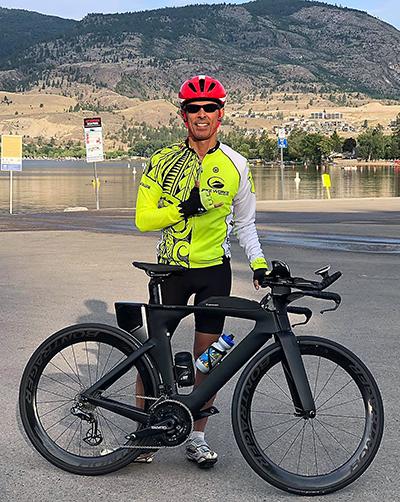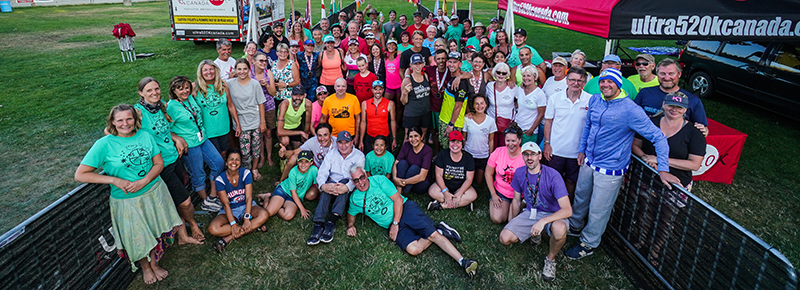
By Michael Linnell
University Communications Director
michael.linnell@minotstateu.edu
Half heart, half science.
That’s how Arnie Strebe ’86 explains being able to finish a 520-kilometer, three-day event known as the Ultra 520K Canada.
“The main goal really is to just finish,” said Strebe, the oldest finisher in the field at age 59. “It’s not about being in the top three or top five, just getting to the finish line each day in each event.”
The former Army Ranger and six-time Ironman finisher knew what his body could do, that is the science part. The heart side — that came from his mantra, “You might see me struggle, but you’ll never see me quit,” and his support team.
“You need a winning team,” he said. “I can’t stress enough how important my support team was. My team captain, who is also a Minot State grad, was my wife, Sigrid (Fiske) ’92. If it was not for her support for 10 months, I would not have finished. Tim Francis ’83, a Minot State Athletics Hall of Famer and my best friend for 38 years, came all the way from Boston to run with me, Chelle Doll, my wife’s best friend, and my coach, Neal Oseland. I interviewed three coaches when I got accepted into the race and a couple who were former Ultraman champions and picked Neal because we have the same approach to coaching.”
The Ultra 520K Canada began in 1993 and is an invite-only race based in Penticton, British Columbia consisting of a 10K swim and 149.8K bike on Day 1, a 275.8K bike on Day 2, and an 84.4K run — or double marathon — on Day 3. All with a 12-hour time limit each day. Applications are sent in two years in advance.
“There is an application process and some minimum requirements, basically they look at what you’ve done and then the race director, Steve Brown, does an interview over the phone,” Strebe said. “Once you are accepted, you get an official letter and put on the website for about a year. I was supposed to race in 2020, but some individuals had to pull out of the race, so they called me. I said yeah right away. My wife said yes, because it would be 10 months of training instead of two years.”
Strebe is no stranger to training — and overcoming odds. He has raced in six Ironman races, including the swim portion in 2009 after his heart stopped beating for nearly 30 seconds during complications due to ulcerative colitis, a pulmonary embolism, and blood clots.

“The doctors told me I wouldn’t compete again, so that’s why I ended up getting my certification to coach, I wanted to stay in the sport,” he said. “But, after one doctor told me I wouldn’t compete, I found another who said I could. With the right meds — I get an infusion every two months, and see a gastroenterologist every two months and probably will for the rest of my life — I did the 2.4- mile swim in 2009, in 2010 I finished my first Ironman, Ironman in 2012, Ironman in 2014, Ironman in 2016, Ironman in 2018, so now I’m looking for a new challenge, and signed up to do the Ultra 520K. I’m healthy and that’s my journey.”
The 2009 swim also gave him the title to his book, “Zero to Something.”
“I wanted to do something,” he said. “I was registered for the Ironman in Florida and I knew I couldn’t do it all. My something was I swam 2.4 miles in Florida, and that became the title of my book.”
He hasn’t looked back since, finishing in fifth place in his age division at a half Ironman event in Wisconsin during his training for the Ultra in June. His newest goal is to earn a spot in the World Championships in the Ironman in New Zealand.
While his training over the past 10 months and his goal of the World Championship have been all-encompassing, he continued to take time to give back to his community, both in Bismarck and at Minot State.
He created an endowment in the Minot State athletic program aimed at scholarships for track & field student-athletes, a sport he competed in during his time at MSU. And, he continues to work with area youth as co-race director for the Starion Bank Missouri Valley Family YMCA Schools Youth Triathlon. The 2019 race featured over 145 participants.

The science part started with his training cycle. While it is impossible to replicate the Ultra’s race-day environment, he was able to use a heart-rate monitor and the rate of perceived exertion to track every workout.
“I built up to those race conditions,” Strebe said. “I did some 8K swims, back and forth in the pool. On the bike, the longest was 8 hours, 15 minutes on a Saturday and for the run it was first on the treadmill, 3 hours, and then eventually outside to work to 3:45, 4, 4:15. I ran a marathon just about every other week. We would build week after week after week. I knew what my body could do full power for one hour and all the workouts were based off a percentage of that. The science is very cool.”
While he physically felt ready for the race, the mental approach to swimming, biking, and running nearly all alone in the Canadian Rockies was a different ballgame. After a crash on the bike on Day 2, his mechanics were a mess heading into Day 3. The first 20 miles of the final run, Strebe contemplated quitting.
But only for a moment, completely oblivious to his support team.
“I wasn’t sure I was going to start on Day 3, my hips were all jacked up, I could barely walk due to the crash, and my hydration was all messed up,” he said. “I get to mile 20 and I throw up three times. From mile 10 to 20, it wasn’t good.”
He drew on inspiration from his team and from the many supporters who had wished him well going into the race to push past the moment of doubt.
“That first about hour and forty-five minutes, those were some of the darkest moments, I had to take a good look at myself,” he said. “Sigrid had these shirts made up with my Army Ranger motto of ‘never quit’ and so they say, ‘You might see me struggle, but you will never see me quit,’ and my team is wearing them, Steve King, the announcer, is telling everyone Arnie Strebe wrote this book called ‘Zero to Something’ about leadership, and over the 10 months of training, I share all of this on Facebook and everyone is leaving comments about good luck and great job Arnie, plenty of love, and I think, how can I be the never quit guy, go back to Bismarck and the Starion Bank (where he was president during the time of the race) team and look at all those people and my wife who pretty much gave up 10 months of her life to support me. How can I quit?
“I get to mile 20, throw up and get past that, and I knew I was done, and by that, I knew I was going to be an Ultraman.”

About Minot State University
Minot State University is a public university dedicated to excellence in education, scholarship, and community engagement achieved through
rigorous academic experiences, active learning environments, commitment to public service, and a vibrant campus life.
Published: 12/02/19




